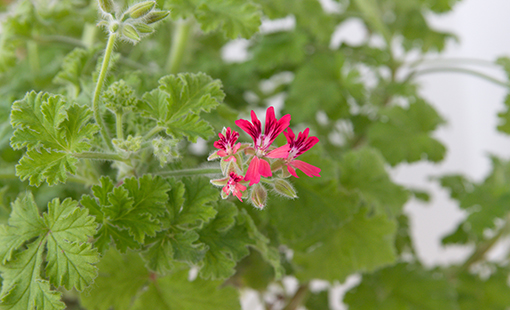
All About Scented-Leaved Geraniums
The term “scented-leaved geraniums” refers to a group of species within the very large Pelargonium genus known to have leaves that emit a fragrance when touched or lightly bruised.
Common name notwithstanding, it’s important to note that this entire group is different than the various cranesbill geraniums, or “true geraniums”—the plants that have the rightful claim to the name Geranium. Scented-leaved geraniums have glands at the base of their leaf hairs, where the scent is formed. Crushing the leaves—or in some cases merely touching them—releases the oil and the scent. The leaves of scented pelargonium geraniums closely resemble those of other garden pelargoniums. There are many shapes, from round to finely cut and lacy, in shades from gray-green to lime green.
Varieties include:
- Apple-scented: Crisp apple scent and small white flowers. Grows to 3 feet tall.
- Chocolate mint: Yummy scent. Round leaves have a dark center ring. Grows 2 feet tall.
- Mosquito plant: A strong citronella scent, though not very effective as a mosquito deterrent. Grows about 2 feet tall.
- Variegated rose geranium: Silver edged, lacy leaves with a rose scent.
Care
Scented-leaved geraniums are generally purchased as small nursery plants. Plant them in average to rich, medium-moisture, well-drained soil; or in pots filled with a peat-based potting mix. Geraniums prefer a slightly acidic soil. Full sun generally provides the best flowering, but they will tolerate part shade.
Pelargoniums are fairly care-free plants that don’t require much in the way of watering and feeding, although potted plants should be monitored for soil moisture. In colder climates, potted specimens can be brought indoors to either sit dormant in a cool, dark area, or placed in a sunny window to grow as a houseplant. Some people dig the plants up entirely, hang them bare-rooted in a cool dark place, and replant in the spring. Not every plant will survive this treatment, but a surprising number do.
Because of their scent and thick leaves, scented geraniums are usually pest-free. Whiteflies are the biggest threat and, less often, aphids, mealybugs and spider mites might attack. Spraying with insecticidal soap or horticultural oil should get rid of them.
Light
Like other garden pelargoniums, scented-leaved geraniums prefer full sun but will tolerate part shade. In very warm climates, some afternoon shade may be beneficial. Shadier conditions may produce leggy plants that require frequent pinching back to keep the plants full.
Soil
Soil should be well-draining, but not too rich. As with herbs and other plants grown for their essential oils, rich soil can lessen the strength of the fragrance. Scented geraniums will tolerate most soil pH, but a slightly acidic pH of about 5.8 to 6.3 is ideal.
Water
Scented geraniums are very drought tolerant and don’t like sitting in wet soil. Water when the soil feels dry about an inch below the surface. Prolonged periods of dry soil will cause the leaves to turn yellow, then brown and fall off, but the plant will come back again with regular water.
Temperature and Humidity
These plants are perennial in tropical climates, so are well-suited for hot, humid conditions. Geraniums also do well in very dry climates. They may survive short periods of light frost but should be brought indoors or discarded when the weather turns cold in winter.
Fertilizer
Go easy on the fertilizer. Scented geraniums are light feeders, and their scent will be stronger if they are grown on the lean side. Potted plants will need more fertilizer than plants in the ground. Potted geraniums can feed a balanced fertilizer at half the label recommended dilution, in the spring and every three to four weeks through summer if they look like they need it. Do not fertilize at all during the winter.
Pruning Scented-Leaved Geraniums
Occasional pinching and pruning will make your scented geranium plants more full and bushy. If your plant gets to be too large, don’t be afraid to prune it back. Spring is the best time to prune because this will give the plants time to set buds and flowers. But large plants can handle some cutting back during any season. You can always root the trimmings. Spent flowers should be dead-headed to stimulate new flower buds.
Growing in Containers
When grown in hanging baskets or patio containers, give these plants a high-quality peat-based potting mix. If you bring potted plants indoors for the winter and grow them as houseplants, give scented geraniums plenty of bright light. They may get leggy in too much shade. If that happens, you can prune lightly to create a bushier plant.
Although success varies, you can also place potted geraniums in a cool, dark space for the winter, allowing them to go dormant in the pots. Trim back the plants by one-half and water deeply before storing them. Through the winter, water lightly every so often to prevent the soil from completely drying out. In the spring, bring the potted plants back outside and water deeply. But don’t be surprised if some plants fail to return from dormancy.
Landscape Uses
Plant scented geraniums where you will rub against them—along with a walkway or at an entrance. These are great plants for containers, filling out and spilling over the edges. Scented geraniums are especially nice in individual pots, clustered together.
Stems and leaves can be used in arrangements or dried for potpourri. Varieties with dense growing small leaves, like Pelargonium crispum, make nice topiaries and small standards. Scented geraniums are edible flowers, and the leaves are often used to scent foods like sugars and jellies.
Information courtesy of TheSpruce.com

 Adams Fairacre Farms
Adams Fairacre Farms